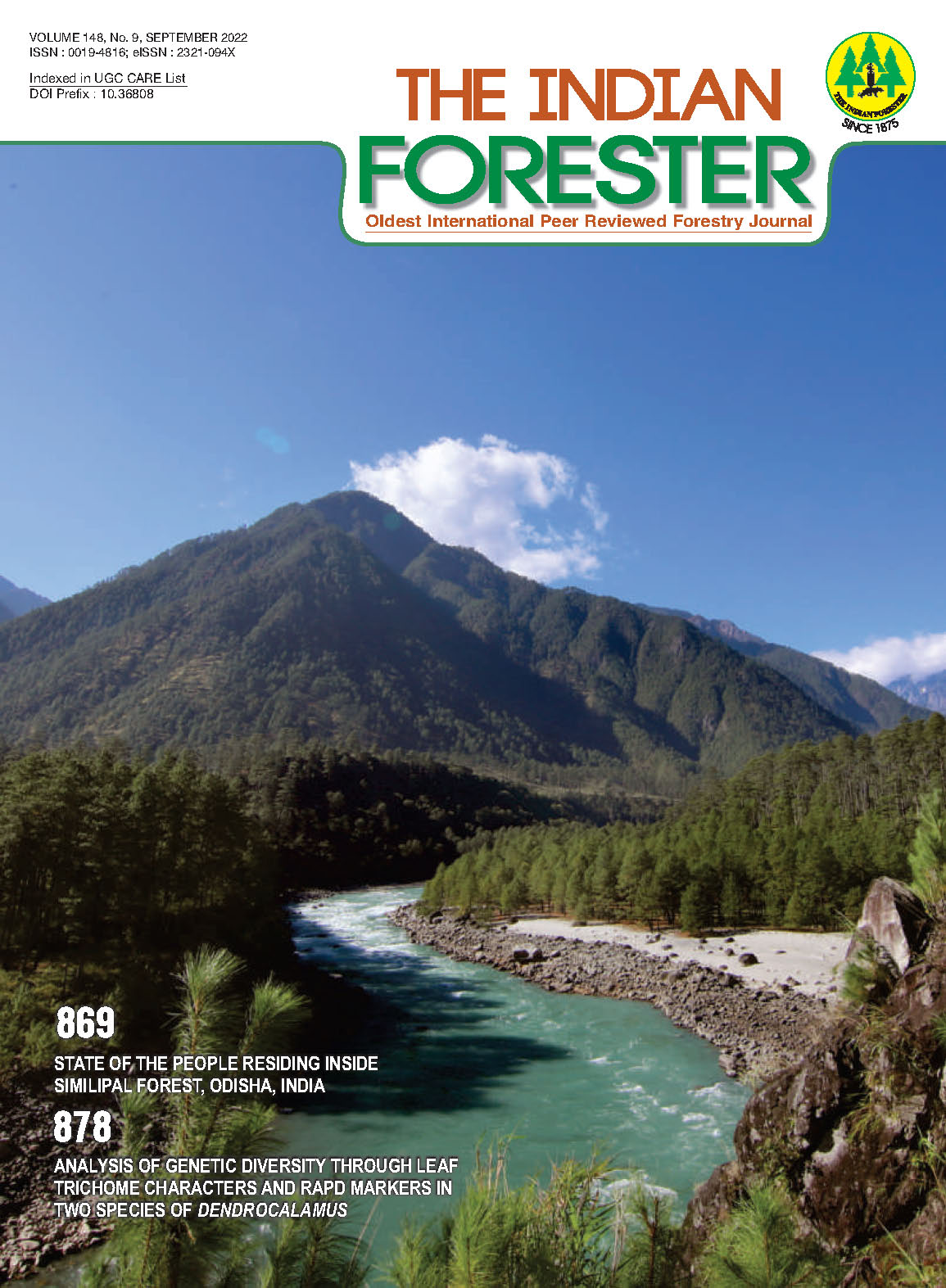Status and Grass Species Diversity of Bandheli Reserve Grassland of Panchmahal District In Gujarat State, India
DOI:
https://doi.org/10.36808/if/2022/v148i9/166036Keywords:
Bandheli, Grass species, Species composition, ThreatsAbstract
In Gujarat, a total of 8,490 km2. area under grassland falls in the eightdistricts. However, a systematic inventory of grassland is not yet done in the
state. The present study deals with the systematic inventory of grass species
diversity and characterization of Bandheli Reserve Grassland. As a result of
the present investigation, a total of 60 grass species have been reported.
Among the recorded 60 grass species, 18 were highly palatable, 22 are
moderately palatable, nine are least palatable, and 11 are unpalatable. This
entire grassland is divided into major types based on the dominant grass and
its composition. This zonation will be used in its management and
improvement. This grassland facing threats of converting into woodland by
tree growth, i.e., out of 754.04 ha, 304 ha area covered by trees and around
100 ha is degraded. The zonation map will be helpful in the management and
improvement of this grassland.
References
Bengtsson J., Bullock J.M., Egoh B., Everson C., Everson T., O'Connor T., O'Farrell P.J., Smith H.G. and Lindbord R. (2019).
Grasslands-more important for ecosystem services than you might think. Ecosphere, 10(2): 1-20, https://doi.org/10.1002/ ecs2.2582 Blair J., Nippert J. and Briggs J. (2014). Grassland Ecology in R.K.
Monson (Ed.). Ecology and the Environment. The Plant Sciences, 8. DOI 10.1007/978-a. Springer Publishers, New York.
Blatter E. and McCann C. (1935). The Bombay grasses. Imperial Council of Agriculture research, Scientific monograph, Manager of Publications, Delhi, xxi, 324 p.
Bor N.L. (1960). The grasses of Burma. Ceylon, India and Pakistan (Excluding Bambuseae). Pergamon Press, New York, 1960. xviii + 767 pp CGWB (2014). Groundwater brochure of Panchmahal District. A technical report compiled by K.M. Mayak, Central Ground Water Board, West Central Region, Ahmedabad, 33 pp.
Cooke T. (1901-1908). The flora of the Presidency of Bombay. Taylor and Francis, London. Vol. I and II.
Dabadghao P. M. and Sankaranarayan K.A. (1973). The grass cover of India, ICAR, New Delhi.
Dixit A.M., Geevan C.P. and Silori C.S. (2001). Status of Natural Terrestrial Vegetation in Gujarat - a reassessment. Indian Forester, 127(5): 533-546 pp.
FAO. (2006). Livestock's long shadow: environmental issues and options. Rome.
FAOSTAT. (2009). Statistical Database 2007. Rome Gandhi D. (2018). Morpho-anatomical Studies of Some Wild Grasses of Gujarat. A Ph.D. thesis submitted to the Maharaja Sayajirao University of Baroda, Vadodra.
Plantureux, Sylvain and Peeters, Alain and McCracken Davy (2005). Biodiversity in intensive grasslands: Effect of management, improvement, and challenges. Agronomy Research, 3: 153-164.
Rahmani A.R. (1992). Threatened fauna of the Indian grasslands. In: Singh, K.P. and Singh, J.S. (eds.) Tropical Ecosystems: Ecology and management, New Delhi. Wiley Eastern, 97-108 pp.
Ramankutty N., Evan A.T., Monfreda C. and Foley J.A. (2008). Farming the planet: 1 Geographic dictribution of global agricultural lands in the year 2000. Global Biogeochem. Cycles, 22(1), GB1003.
Rawat G.S. and Adhikari B.S. (Eds.) (2015). Ecology and management of Grassland Habitats in India, ENVIS Bulletin: Wildlife & Protected areas. Vol 17. Wildlife Institute of India, Dehradun, India.
SAC (2002). Grassland mapping in Gujarat using Remote sensing and GIS techniques: Kachchh district. Space Application Centre, Ahmedabad. 36 p.
Shah G.L. (1978). Flora of Gujarat state.Sardar Patel University. Pp. 1074 Stebbins G.L. (1981). Co-evolution of grasses and herbivores. Annals of the Missouri Botanical Gardens, 68: 75-86 pp.
Verma A. and Prakash V. (2007). Winter roost habitat use by Eurasian Marsh harriers Circus aeruginosus in and around Keoladeo National Park, Bharatpur, Rajasthan, India. Forktail, 23: 17-21 pp.
Vijay Kumar V., Mahato A.K.R and Patel R. (2015). Ecology and Management of Banni Grasslands of Kachchh, Gujarat In G.S.Rawat and B.S. Adhikari (Eds.) Ecology and Management of Grassland Habitats in India, ENVIS Bulletin: Wildlife and Protected Areas, Wildlife Institute of India, Dehradun-248001, India, Vol. 17: 11-22 pp.
White R.P., Murray S. and Rohweder M. (2000). Pilot analysis of global ecosystems: Grassland Ecosystem. World Resource Institute, Washington DC., 69 p.
Downloads
Published
How to Cite
Issue
Section
License
Unless otherwise stated, copyright or similar rights in all materials presented on the site, including graphical images, are owned by Indian Forester.





